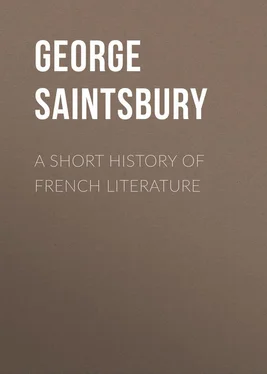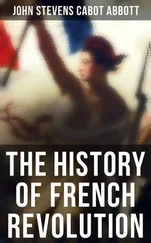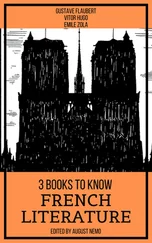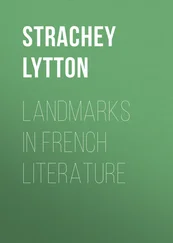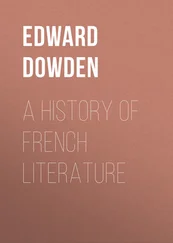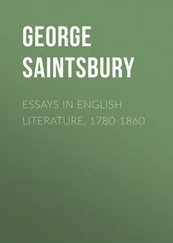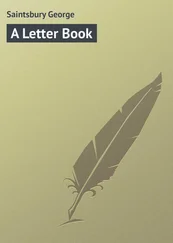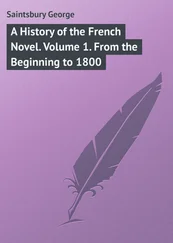George Saintsbury - A Short History of French Literature
Здесь есть возможность читать онлайн «George Saintsbury - A Short History of French Literature» — ознакомительный отрывок электронной книги совершенно бесплатно, а после прочтения отрывка купить полную версию. В некоторых случаях можно слушать аудио, скачать через торрент в формате fb2 и присутствует краткое содержание. ISBN: , Жанр: foreign_prose, на английском языке. Описание произведения, (предисловие) а так же отзывы посетителей доступны на портале библиотеки ЛибКат.
- Название:A Short History of French Literature
- Автор:
- Жанр:
- Год:неизвестен
- ISBN:http://www.gutenberg.org/ebooks/33062
- Рейтинг книги:3 / 5. Голосов: 1
-
Избранное:Добавить в избранное
- Отзывы:
-
Ваша оценка:
- 60
- 1
- 2
- 3
- 4
- 5
A Short History of French Literature: краткое содержание, описание и аннотация
Предлагаем к чтению аннотацию, описание, краткое содержание или предисловие (зависит от того, что написал сам автор книги «A Short History of French Literature»). Если вы не нашли необходимую информацию о книге — напишите в комментариях, мы постараемся отыскать её.
A Short History of French Literature — читать онлайн ознакомительный отрывок
Ниже представлен текст книги, разбитый по страницам. Система сохранения места последней прочитанной страницы, позволяет с удобством читать онлайн бесплатно книгу «A Short History of French Literature», без необходимости каждый раз заново искать на чём Вы остановились. Поставьте закладку, и сможете в любой момент перейти на страницу, на которой закончили чтение.
Интервал:
Закладка:
The Roman du Renart.
Closely connected with the Fabliaux is one of the most singular works of mediaeval imagination, the Roman du Renart 62 62 It should be noticed that this title, though consecrated by usage, is a misnomer. It should be Roman de Renart , for this latter is a proper name. The class name is goupil (vulpes). The standard edition is that of Méon (4 vols., Paris, 1826) with the supplement of Chabaille, 1835. This includes not merely the Ancien Renart , but the Couronnement and Renart le Nouvel . Renart le Contrefait has never been printed. Rothe (Paris, 1845) and Wolf (Vienna, 1861) have given the best accounts of it. Recently M. Ernest Martin has given a new critical edition of the Ancien Renart (3 vols., Strasburg and Paris, 1882-1887).
. This is no place to examine the origin or antiquity of the custom of making animals the mouthpieces of moral and satirical utterance on human affairs. It is sufficient that the practice is an ancient one, and that the middle ages were early acquainted with Aesop and his followers, as well as with Oriental examples of the same sort. The original author, whoever he was, of the epic (for it is no less) of 'Reynard the Fox,' had therefore examples of a certain sort before his eyes. But these examples contented themselves for the most part with work of small dimension, and had not attempted connected or continuous story. A fierce battle has been fought as to the nationality of Reynard. The facts are these. The oldest form of the story now extant is in Latin. It is succeeded at no very great interval by German, Flemish, and French versions. Of these the German as it stands is apparently the oldest, the Latin version being probably of the second half of the twelfth century, and the German a little later. But (and this is a capital point) the names of the more important beasts are in all the versions French. From this and some minute local indications, it seems likely that the original language of the epic is French, but French of the Walloon or Picard dialect, and that it was written somewhere in the district between the Seine and the Rhine. This, however, is a matter of the very smallest literary importance. What is of great literary importance is the fact that it is in France that the story receives its principal development, and that it makes its home. The Latin, Flemish, and German Reynards, though they all cover nearly the same ground, do not together amount to more than five-and-twenty thousand lines. The French in its successive developments amounts to more than ninety thousand in the texts already published or abstracted; and this does not include the variants in the Vienna manuscript of Renart le Contrefait , or the different developments of the Ancien Renart , recently published by M. Ernest Martin.
The Ancien Renart.
The order and history of the building up of this vast composition are as follows. The oldest known 'branches,' as the separate portions of the story are called, date from the beginning of the thirteenth century. These are due to a named author, Pierre de Saint Cloud. But it is impossible to say that they were actually the first written in French: indeed it is extremely improbable that they were so. However this may be, during the thirteenth century a very large number of poets wrote pieces independent of each other in composition, but possessing the same general design, and putting the same personages into play. In what has hitherto been the standard edition of Renart , Méon published thirty-two such poems, amounting in the aggregate to more than thirty thousand verses. Chabaille added five more in his supplement, and M. Ernest Martin has found yet another in an Italianised version. This last editor thinks that eleven branches, which he has printed together, constitute an 'ancient collection' within the Ancien Renart , and have a certain connection and interdependence. However this may be, the general plan is extremely loose, or rather non-existent. Everybody knows the outline of the story of Reynard; how he is among the animals (Noble the lion, who is king, Chanticleer the cock, Firapel the leopard, Grimbart the badger, Isengrin the wolf, and the rest) the special representative of cunning and valour tempered by discretion, while his enemy Isengrin is in the same way the type of stupid headlong force, and many of the others have moral character less strongly marked but tolerably well sustained. How this general idea is illustrated the titles of the branches show better than the most elaborate description. 'How Reynard ate the carrier's fish;' 'how Reynard made Isengrin fish for eels;' 'how Reynard cut the tail of Tybert the cat;' 'how Reynard made Isengrin go down the well;' 'of Isengrin and the mare;' 'how Reynard and Tybert sang vespers and matins;' 'the pilgrimage of Reynard,' and so forth. Written by different persons, and at different times, these branches are of course by no means uniform in literary value. But the uniformity of spirit in most, if not in all of them, is extremely remarkable. What is most noticeable in this spirit is the perpetual undertone of satirical comment on human life and its affairs which distinguishes it. The moral is never obtrusively put forward, and it is especially noteworthy that in this Ancien Renart , as contrasted with the later development of the poem, there is no mere allegorising, and no attempt to make the animals men in disguise. They are quite natural and distinct foxes, wolves, cats, and so forth, acting after their kind, with the exception of their possession of reason and language.
Le Couronnement Renart.
The next stage of the composition shows an alteration and a degradation. Renart le Couronné , or Le Couronnement Renart 63 63 The necessary expression of the genitive by de is later than this. Mediaeval French retained the inflection of nouns, though in a dilapidated condition. Properly speaking Renars is the nominative, Renart the general inflected case.
, is a poem of some 3400 lines, which was once attributed to Marie de France, for no other reason than that the manuscript which contains it subjoins her Ysopet or fables. It is, however, certainly not hers, and is in all probability a little later than her time. The main subject of it is the cunning of the fox, who first reconciles the great preaching orders Franciscans and Dominicans; then himself becomes a monk, and inculcates on them the art of Renardie ; then repairs to court as a confessor to the lion king Noble who is ill, and contrives to be appointed his successor, after which he holds tournaments, journeys to Palestine, and so forth. It is characteristic of the decline of taste that in the list of his army a whole bestiary (or list of the real and fictitious beasts of mediaeval zoology) is thrust in; and the very introduction of the abstract term Renardie , or foxiness, is an evil sign of the abstracting and allegorising which was about to spoil poetry for a time, and to make much of the literature of the fourteenth and fifteenth centuries tedious and heavy. The poem is of little value or interest. The only chronological indication as to its composition is the eulogy of William of Flanders, killed ('jadis,' says the author) in 1251.
Renart le Nouvel.
The next poem of the cycle is of much greater length, and of at least proportionately greater value, though it has not the freshness and verve of the earlier branches. Renart le Nouvel was written in 1288 by Jacquemart Giélée, a Fleming. This poem is in many ways interesting, though not much can be said for its general conception, and though it suffers terribly from the allegorising already alluded to. In its first book (it consists of more than 8000 lines, divided into two books and many branches) Renart, in consequence of one of his usual quarrels with Isengrin, gets into trouble with the king, and is besieged in Maupertuis. But the sense of verisimilitude is now so far lost, that Maupertuis, instead of being a fox's earth, is an actual feudal castle; and more than this, the animals which attack and defend it are armed in panoply, ride horses, and fight like knights of the period. Besides this the old familiar and homely personages are mixed up with a very strange set of abstractions in the shape of the seven deadly sins. All this is curiously blended with reminiscences and rehandlings of the older and simpler adventures. Another remarkable feature about Renart le Nouvel is that it is full of songs, chiefly love songs, which are given with the music. Its descriptions, though prolix, and injured by allegorical phrases, are sometimes vigorous.
Читать дальшеИнтервал:
Закладка:
Похожие книги на «A Short History of French Literature»
Представляем Вашему вниманию похожие книги на «A Short History of French Literature» списком для выбора. Мы отобрали схожую по названию и смыслу литературу в надежде предоставить читателям больше вариантов отыскать новые, интересные, ещё непрочитанные произведения.
Обсуждение, отзывы о книге «A Short History of French Literature» и просто собственные мнения читателей. Оставьте ваши комментарии, напишите, что Вы думаете о произведении, его смысле или главных героях. Укажите что конкретно понравилось, а что нет, и почему Вы так считаете.
